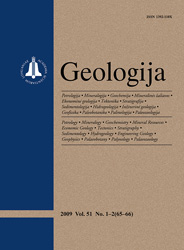Geologija / Geology
WHAT?
 ISSN 1392-110X ISSN 2029-056X (online) |
2007 m. Nr. 4 Composition and formation of sand massifs in the Curonian–Sambian submarine plateau (Baltic Sea)
Geological and geophysical investigations were carried out in the Juodkrantė–Preila polygon westwards of the Curonian Spit. Sand massifs on the sea bottom of the Curonian–Sambian plateau appear as hilly elevations of a relative height of up to 4–5 m and extend in the southern–northern and southwestern–northeastern directions. The dominant type of the bottom surface sediments at a depth of 5 to 50 m and deeper is grey and yellowish grey, good-sorted quartzy fine sand. The central parts of the elevations are mainly composed of homogenous light yellow and yellowish grey medium sand and coarse sand lies only in small local areas at a depth of 20–28 m. The applied seismoacoustic methods allowed to affirm the fact that the sand layers of the bottom elevations are not less than 4–5 m thick. The sand massifs in the underwater slope of the Curonian Spit started developing during the Ancylus Lake regression. The intensive sand accumulation coincided with the first phase of the Litorina transgression when the sedimentary material flows from the eroded underwater slope of the Sambian peninsula intensified. At times, fluvial and eolian processes (Ancylus stage) might have added variety to the uneven and discontinuous sand accumulation yet hydrodynamic factors have always played a decisive role. Distribution patterns of the grain-size composition and the types of the surficial sediments in the underwater slope of the Curonian Spit show that there is no circulation of sedimentary material between the shallow nearshore and hilly sand massif. Thus, the present coastal zone of the Curonian Spit is virtually independent of the lithodynamic processes taking place in the plateau surface (deeper than 20 m).
Raktažodžiai: Baltic Sea, sand massifs, grain-size, surficial sediments, seismoacoustic profiles, accumulation processes, underwater slope evolution |
Issues:
2011 - Vol.53 No. 1, No. 2, No. 3 2010 - Vol.52 No. 1-4 2009 - Vol.51 No. 1-2, No. 3-4 2008 - Vol.50 No. 1, No. 2, No. 3, No. 4, No. Priedas 2007 No. 1, No. 2, No. 3, No. 4 2006 No. 1, No. 2, No. 3, No. 4 2005 No. 1, No. 2, No. 3, No. 4 2004 No. 1, No. 2, No. 3, No. 4 2003 No. 1, No. 2, No. 3, No. 4 2002 No. 1, No. 2, No. 3, No. 4 2001 No. 1, No. 2, No. 3, No. 4 |